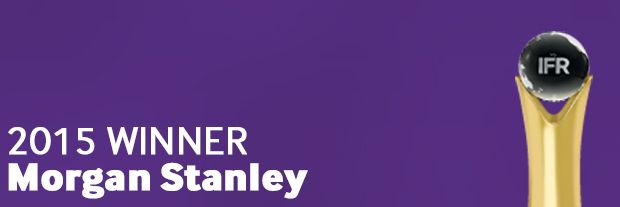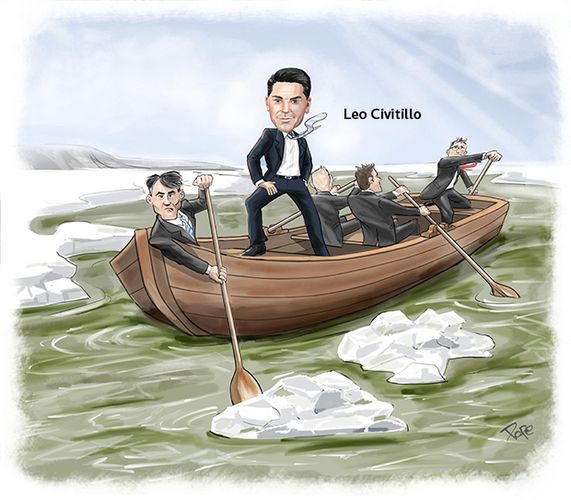Special delivery
The deals in the US bond markets were jumbo-sized in 2015, but so were the problems. Regulation, volatility, rates – everything, it seemed, gave investors reason for pause. But Morgan Stanley proved time and again it could execute high-grade deals despite all the noise and the chatter, making it IFR’s US Investment-Grade Bond House of the Year.
It’s easy for any decent bank to perform when the markets are warm and cuddly and the stars are aligned. But delivering the goods when conditions are tough is an entirely different matter. That’s when issuers need proven expertise, market intelligence and creative solutions – and that’s when they call on Morgan Stanley.
For years, Morgan Stanley has had a prominent role in the most talked-about financings in the US investment-grade market. It was near the top of the Thomson Reuters league tables again in the IFR awards period, coming in fourth with 269 deals for US$85bn, good for a 7.9% share of the high-grade market.
But the bank truly stands out when sentiment is low and the stakes are high – something it demonstrated over and over again across a very bumpy 2015.
With a balance sheet that is a fraction of those of the money-centre commercial banks, Morgan Stanley continued to focus on innovative solutions and new ideas, and expanded on niches it had discovered a year earlier to be successful in getting a lead role on a wide variety of transactions for corporates and financial institutions.
“The fact that we have a consistent top-five presence in league tables show that a vast majority of our clients appreciate our proven ability to come up with cost-efficient solutions,” said Leo Civitillo, the bank’s global co-head of fixed income capital markets.
“We have consistently optimised execution by tapping different sources of liquidity, currencies and solutions along with differentiated institutional, middle-market and retail distribution.”
The bank focused more on mid-market client distribution during the review period compared with earlier years, adding a new dimension to bookbuilding in the US high-grade market – where bonds were mostly sold to just the top tier clients.
This extra push to also target investors with smaller orders did require more effort and resources but it gave the bank an edge while vying for mandates as clients were assured of diversity in the distribution of their bonds.
The bank was an active bookrunner on two of the three largest high-grade deals of the year, including AbbVie’s US$16.7bn six-part acquisition financing. Execution was supported by a two-day campaign on the phones to more than 150 investors. The result? A massive US$60bn order book that allowed AbbVie to sell maturities from three to 30 years – all with new issue concessions of 5bp or less.
AT&T was another success story, selling a US$17.5bn six-part trade with tenors from five to 31 years. Morgan Stanley helped the telecoms giant price the deal about 20bp–30bp tighter than whispers, with concessions from about negative 1bp to 5bp across the curve. The final book was a whopping US$68bn.
The bank was also one of the active bookrunners on UnitedHealth’s jumbo US$10.5bn deal in July, where a US$41bn order book underscored the bid for the health sector as well as liquid M&A trades. UnitedHealth, which was using proceeds to fund its US$12.8bn purchase of pharmacy benefit manager Catamaran, was able to tighten pricing by 20bp–25bp from start to finish. The bonds tightened further in secondary trading.
The bank was active on PNC Financial’s US$3bn deal in May – its largest debt offering and its first with four separate tranches. Morgan Stanley was also a joint bookrunner on RBS’s US$3.15bn deal, one of the largest ever US dollar AT1 trades.
Elsewhere in the Yankee space, Morgan Stanley delivered Royal Dutch Shell’s US$10bn offering; it was lead-left on Alibaba Group’s US$8.08bn trade in November 2104 and it helped get ABN AMRO, Lloyds Banking Group, Rabobank, MUFG and other European and Asian borrowers over the line.
The bank was also one of four bookrunners on AstraZeneca’s US$6bn bond issue to help finance its purchase of US biotech company ZS Pharma in November. The British drugmaker pulled in pricing by 10bp–15bp from initial price thoughts on its offering of three, five, 10 and 30-year fixed-rate tranches, on order books of close to US$14bn.
It also brought to market a number of deals from asset managers and other niche names including KKR, Blackstone Group and Neuberger Berman.
“We have delivered best-in-class global fixed-income solutions for a variety of clients across the ratings spectrum that included record-breaking debt offerings across a variety of categories,” said Civitillo.
To see the digital version of the IFR Americas Review of the Year, please click here .
To purchase printed copies or a PDF of this report, please email gloria.balbastro@tr.com .

